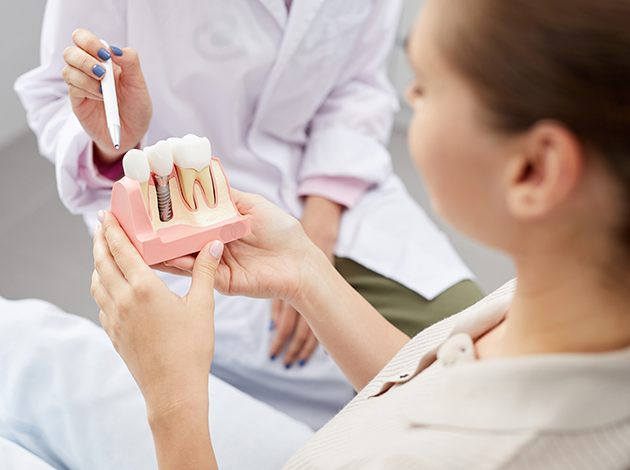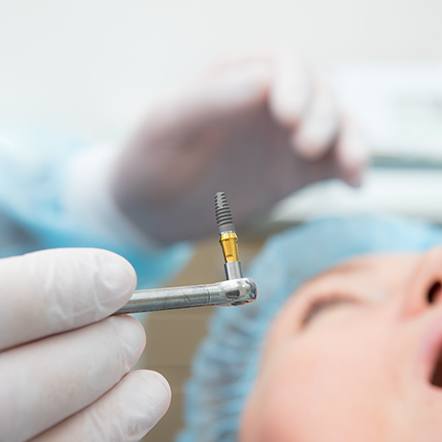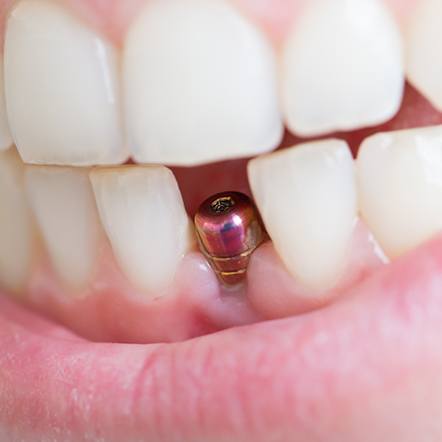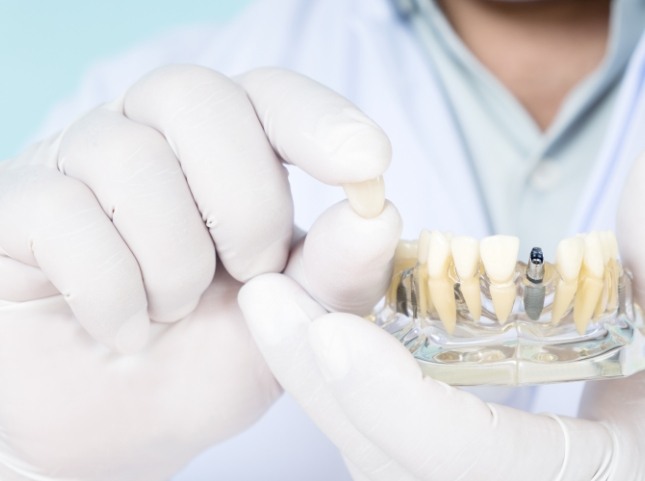Dental Implants – San Ramon, CA
An Advanced Solution for Tooth Replacement
The best choice for replacing missing teeth isn’t necessarily the same for every patient. That being said, dental implants are often highly recommended for filling any gaps in your grin – regardless of how many teeth are missing. Unlike traditional dentures and bridges, dental implants can act like new tooth roots. As such, they offer all kinds of benefits that you wouldn’t be able to enjoy otherwise. You can find out more about dental implants in San Ramon – and whether they’re right for you – by calling to set up a consultation at Gale Ranch Family Dental.
Why Choose Gale Ranch Family Dental for Dental Implants?
- Entire Dental Implant Process Handled In-House
- Cone Beam Scanner for Accurate Placement
- Team That Cares About Customer Service
What Are Dental Implants?

The most common type of dental implants is endosteal implants. They are intended to be placed in the jaw, and as such they are typically made out of titanium, a metal known for its ability to join with bone tissue. Dental implants are very sturdy compared to other forms of tooth replacement, and they can prevent your new teeth from slipping at inopportune moments. A metal connector piece called an abutment is used to attach the final crown, bridge, or denture to your dental implant(s).
The 4-Step Dental Implant Process

Dental implants tend to be more resilient and last longer than alternatives like dentures and dental bridges. However, placing them involves a multi-step process that requires several appointments spanning several months. This is because they’re the only treatment that involves oral surgery for more reliable replacement teeth.
Fortunately, our Gale Ranch Family Dental team includes both general dentists and specialists, such as oral surgeons, who can place your implant and restoration in the office to streamline your experience. Continue reading to learn more about the step-by-step process of getting dental implants, and feel free to contact us for additional information!
Initial Dental Implant Consultation

Before proceeding, you must consult one of our experts to confirm that this is the best treatment for your unique circumstances. We’ll start by updating your medical history and listing any current prescriptions or supplements you’re taking to ensure we don’t interfere with your general health.
Then, we’ll examine your mouth to ensure that no pre-existing problems, such as cavities or gum disease, interfere with the results. We’ll also measure your jawbone density to verify whether it’s thick enough to support implants. If it’s not, you may need an additional bone graft procedure to bulk it up to continue.
Dental Implant Surgery

We have specialists on our team who are experts at placing implants and restoring smiles, and we’re equipped with state-of-the-art technology to perform each step of the process onsite. When you arrive for your surgery, we’ll begin by numbing the area with a local anesthetic and/or sedating you so you feel comfortable and relaxed the entire time.
Next, we’ll make a small incision in your gums to place the appropriate number of titanium rods, based on your situation. Some patients replace only one tooth, while others may require several metal posts to support permanently anchored bridges or dentures. Then, we’ll close your gums and place protective caps over your implants to protect them.
Dental Implant Osseointegration & Abutment

It takes three to six months to recover from your procedure because your jawbone must fuse with the titanium support in a process called osseointegration. Once placed, the pole stimulates your jaw to generate new bone growth with each bite. Eventually, enough material is created to envelop and merge with your implant.
Once you’ve healed sufficiently, our team will schedule a minor procedure to place an abutment on top of the post, which will be used to anchor your lifelike dental crown or other restoration.
Delivery of Dental Implant Restoration(s)

Once your prosthetic is designed and delivered, we’ll schedule a fitting for you. Our team will check that it functions as intended and doesn’t interfere with your bite alignment when you close your teeth together. If everything checks out, we’ll secure it in place with special dental cement and then remove any excess material. Finally, we’ll polish it to a shine and send you on your way with a newly perfected smile!
Benefits of Dental Implants

With more than half a million dental implants placed every year, these incredible prosthetic devices are quickly becoming one of the most popular ways to restore lost teeth. Because of the unique process by which they are placed in the jawbone, dental implants can deliver a range of remarkable benefits that you cannot get with traditional restorations like dental bridges and dentures. Here’s a quick look at how dental implants can enhance your quality of life, confidence, and overall health.
Day-to-Day Benefits

Dental implants can improve your daily life in ways like:
- Allowing you to chew anything you could with real teeth, which means that you’ll be free to enjoy crunchy, chewy, and tough fare like tender steaks, smoky corn-on-the-cob, and snappy raw fruits and vegetables.
- Being easy to brush and floss so you won’t have to worry about the intensive cleaning and maintenance rituals required by traditional restorations like dentures.
- Giving you a complete smile that you’ll be proud to show off to friends, family, and coworkers.
- Staying firmly in place within the mouth so you don’t have to worry about them slipping when you are speaking or chewing.
Health Benefits

Dental implants also offer a range of incredible health benefits like:
- Giving you the superior chewing power you need to enjoy a diverse and nutritious diet so you can avoid issues like indigestion and malnutrition.
- Supporting neighboring teeth so they don’t drift out of alignment.
- Protecting the gums from injury.
- Remaining in position so they don’t irritate your soft tissues or damage your enamel by sliding around.
- Simple hygiene requirements make it easy to avoid nasty oral infections like tooth decay and gum disease as well as bad breath.
Long-Term Benefits

Dental implants can also deliver a number of long-term benefits. A few of these include:
- A 95% success rate even ten years after they are placed, which makes them a smart investment in your oral health.
- Lasting for several decades or even a lifetime if they receive excellent care that includes excellent oral hygiene, regular dental checkups at our San Ramon office, and protection from injury.
- Not requiring frequent replacement appliances, which can save the patient thousands of dollars over the years.
- Giving you the confidence you need to smile proudly and make excellent first impressions at job interviews, employee reviews, and sales opportunities.
Who Dental Implants Can Help

A knowledgeable dental expert can tell you whether or not dental implants are an option worth pursuing in your specific case. Most adults who have an adequate amount of bone in their jaws are able to have dental implants placed (assuming they’re also in good oral health in general). The implant placement process will be personalized based on the number of teeth missing: here’s a brief look at the various tooth loss situations they can help with.
Missing One Tooth

Losing a tooth is more than just a cosmetic problem; you should fill the gap as soon as possible even if it’s in a place where no one besides you and your dentist will ever see it. After we insert a dental implant in the empty space and give it time to join with the bone, we will eventually be able to attach a crown made from lifelike tooth-colored materials.
Missing Multiple Teeth

After losing three or more consecutive teeth, you may worry that you’ll need to get the same number of dental implant posts to completely fill in the gap. In many cases, though, only two posts are necessary. We can simply attach a bridge to said posts in order to replace multiple teeth at once. One advantage of an implant bridge is that we don’t have to remove any enamel from the natural teeth you still have in order to place it.
Missing All of Your Teeth

As alarming as the idea of losing all of your teeth may be, it is possible to fully restore your smile from the roots up thanks to implant dentures. In some cases, implant dentures are made to be removable. However, many patients prefer them to be permanently anchored to the mouth; that way, they never have to worry about removing their new teeth for cleanings.
Understanding the Cost of Dental Implants

You’ll need to speak to our team in order to get an estimate of how much your dental implants will cost, but you can generally expect to pay more upfront than you would for a traditional bridge or denture. That being said, as long as you do a good job of protecting and maintaining your dental implants, you can expect them to last for decades at a time, meaning you don’t need to worry about paying for new ones very often.

